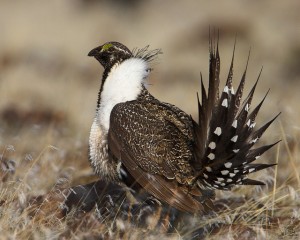by Jordana Fremed, Summer Intern
 In September 2015, the U.S. Fish and Wildlife Service will decide whether or not to list the greater sage-grouse as threatened under the Endangered Species Act of 1973.[1] The proposed listing has caused conflict between two groups of environmentalists: conservationists and advocates of renewable energy such as wind power.
In September 2015, the U.S. Fish and Wildlife Service will decide whether or not to list the greater sage-grouse as threatened under the Endangered Species Act of 1973.[1] The proposed listing has caused conflict between two groups of environmentalists: conservationists and advocates of renewable energy such as wind power.
The greater sage-grouse, or Centrocercus urophasianus, is a chicken-like bird known for its eccentric mating strut. The bird is found in grassland areas, specifically sagebrush country, in the western United States and southern Alberta and Saskatchewan in Canada. The sage-grouse has experienced a rapid population decline in the past century due to loss of habitat from grazing, logging, and the installation of wind farms.In order to thrive, the species needs large open spaces unrestricted by tall structures such as trees or windmills where predators might perch.[2]
If the U.S. Fish and Wildlife Service lists the sage-grouse as threatened, a large percentage of the country will face restrictions on renewable energy development. The sage-grouse’s inhabited range stretches over 165 million acres across 11 states including Washington, Oregon, California, Nevada, Idaho, Montana, Wyoming, Colorado, Utah, South Dakota, North Dakota, Kansas, Oklahoma, Nebraska, New Mexico, and Arizona.[3] Avian biology studies have shown that sage-grouse avoid areas near high structures such as wind turbines, which are possible perches for birds of prey.[4] Already more than two dozen energy projects have been altered or denied in the West, and more wind developments are projected to be affected if the species is listed. Listing could severely affect states like Wyoming, which has a large potential for renewable wind power. If the sage-grouse were listed as threatened, their habitat, covering about 80% of Wyoming, would be restricted from wind farm development.[5]
On October 28th, 2013, the U.S Fish and Wildlife Service announced a proposal to list the bi-state distinct population segment of the sage-grouse as threatened and to protect its critical habitat. Since then, the decision has been postponed 45 days then another six months, and now again to September of 2015, to ensure the “sufficiency or accuracy of the available data relevant to the proposed listing, making it necessary to solicit additional information.”[6] The Fish and Wildlife Service indicates in the postponements that it is making every effort to make the most well informed decision that takes into account all deciding factors, one of which most recently mentioned, is climate change. In a June 3rd 2014 Federal Register notice, the Service called for a request of information on the management of potential climate change effects in proposed critical habitat areas.[7]
The wind energy industry has used the one year delay to make its case that federal regulation is not necessary for sage-grouse protection in high wind power areas. The American Wind Energy Association has taken its own measures to protect the sage-grouse so that both wind farm development and the sage-grouse population can safely coexist without a federal threatened listing. The American Wind Energy Association prepared comments on draft management documents prepared by Bureau of Land Management and the states encompassing the sage-grouse historic range. Additionally, the National Wind Coordinating Collaborative, Wildlife Workgroup’s Grassland and Shrub Steppe Species Subgroup (GS3) formed the Sage-Grouse Research Collaborative with the goal of coordinating studies that examine the potential impacts of wind energy development on sage-grouse. Since its establishment, the group has funded and managed three ongoing studies to evaluate wind energy’s impacts on the sage-grouse population and find ways to “avoid, minimize, and mitigate for these impacts once their extent is quantified.” [8] Since then, the committee has awarded various western state power companies funding for conservation efforts.[9]
The upcoming decision has raised a question regarding what to do when two pressing environmental priorities clash with one another. Some climate change and renewable energy activists feel that wind power development can be implemented in such a way that does not heavily impact the greater sage-grouse and require federal intervention under the Endangered Species Act. Federal intervention also arguably undermines the nation’s ability to develop renewable resources for greenhouse gas emission reductions and energy independence.[10] Some conservationists however, contend that the species must be saved at all costs including the economic losses that come about as a result of protecting the area, and to do so federal protection is necessary.[11] When two environmental issues come into conflict, the “right” action is not always so clear.
[1] Endangered and Threatened Wildlife and Plants; Threatened Status for the Bi-State Distinct Population Segment of Greater Sage-Grouse With Special Rule. 79 Federal Register 45420-21, August 5, 2014. https://www.gpo.gov/fdsys/pkg/FR-2014-08-05/pdf/2014-18180.pdf.
[2] Greater Sage-Grouse- Species Information. U.S. Fish and Wildlife Service. 8 Aug 2014. https://www.fws.gov/greaterSageGrouse/speciesinfo.php.
[3] Greater Sage-Grouse- Species Information, supra note 2.
[4] Sage-Grouse and Wind Energy: The West is Where the Wind Blows. Native Ecosystem, Aug. 8, 2014. https://rockymountainwild.org/_site/wp-content/uploads/Sage-Grouse-and-Wind-Energy.pdf.
[5]Birds Versus Wind Turbines: (New York Times. Jul. 22 2014) available at https://www.youtube.com/watch?v=O6y-uz6h9G4
[6] Endangered and Threatened Wildlife and Plants, supra note 1 at 45420.
[7] Id. at 45420.
[8] Explore the Issues: Sage Grouse and Wind Energy. AMERICAN WIND ENERGY ASSOCIATION. 8 Aug 2014. https://www.awea.org/Issues/Content.aspx?ItemNumber=835
[9] Supra note 8
[10]Davies, Steve. Calvert Addresses Sage-Grouse Provisions in Spending Bill, Endangered Species Wetland Report, Aug. 4, 2014. https://www.eswr.com/2014/07/calvert-addresses-sage-grouse-provisions-in-spending-bill.
[11] Supra note 1

